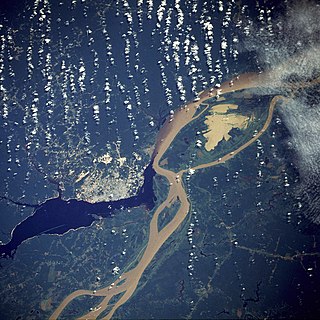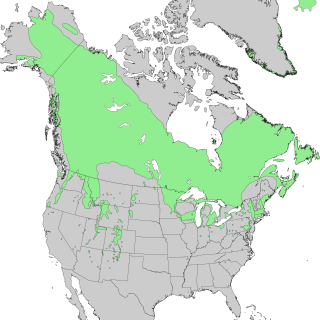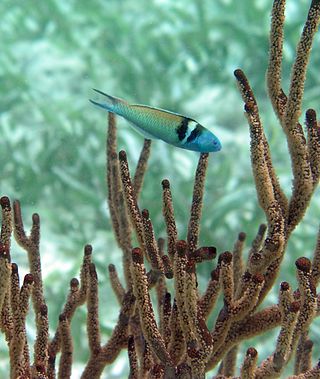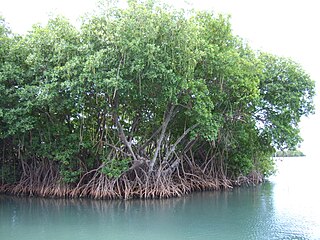Related Research Articles

An ecoregion is an ecologically and geographically defined area that is smaller than a bioregion, which in turn is smaller than a biogeographic realm. Ecoregions cover relatively large areas of land or water, and contain characteristic, geographically distinct assemblages of natural communities and species. The biodiversity of flora, fauna and ecosystems that characterise an ecoregion tends to be distinct from that of other ecoregions. In theory, biodiversity or conservation ecoregions are relatively large areas of land or water where the probability of encountering different species and communities at any given point remains relatively constant, within an acceptable range of variation . Ecoregions are also known as "ecozones", although that term may also refer to biogeographic realms.
This is an index of conservation topics. It is an alphabetical index of articles relating to conservation biology and conservation of the natural environment.
Conservation status is a measure used in conservation biology to assess an ecoregion's degree of habitat alteration and habitat conservation. It is used to set priorities for conservation.

Conservation biology is the study of the conservation of nature and of Earth's biodiversity with the aim of protecting species, their habitats, and ecosystems from excessive rates of extinction and the erosion of biotic interactions. It is an interdisciplinary subject drawing on natural and social sciences, and the practice of natural resource management.

Landscape ecology is the science of studying and improving relationships between ecological processes in the environment and particular ecosystems. This is done within a variety of landscape scales, development spatial patterns, and organizational levels of research and policy. Concisely, landscape ecology can be described as the science of "landscape diversity" as the synergetic result of biodiversity and geodiversity.

Urban ecology is the scientific study of the relation of living organisms with each other and their surroundings in an urban environment. An urban environment refers to environments dominated by high-density residential and commercial buildings, paved surfaces, and other urban-related factors that create a unique landscape. The goal of urban ecology is to achieve a balance between human culture and the natural environment.

Habitat conservation is a management practice that seeks to conserve, protect and restore habitats and prevent species extinction, fragmentation or reduction in range. It is a priority of many groups that cannot be easily characterized in terms of any one ideology.

An ecosystem engineer is any species that creates, significantly modifies, maintains or destroys a habitat. These organisms can have a large impact on species richness and landscape-level heterogeneity of an area. As a result, ecosystem engineers are important for maintaining the health and stability of the environment they are living in. Since all organisms impact the environment they live in one way or another, it has been proposed that the term "ecosystem engineers" be used only for keystone species whose behavior very strongly affects other organisms.

Ecological restoration, or ecosystem restoration, is the process of assisting the recovery of an ecosystem that has been degraded, damaged, or destroyed. It is distinct from conservation in that it attempts to retroactively repair already damaged ecosystems rather than take preventative measures. Ecological restoration can reverse biodiversity loss, combat climate change, and support local economies. Habitat restoration involves the deliberate rehabilitation of a specific area to reestablish a functional ecosystem. To achieve successful habitat restoration, it's essential to understand the life cycles and interactions of species, as well as the essential elements such as food, water, nutrients, space, and shelter needed to support species populations. When it's not feasible to restore habitats to their original size or state, designated areas known as wildlife corridors can be established. These corridors connect different habitats and open spaces, facilitating the survival of species within human-dominated landscapes. For instance, marshes serve as critical stopover sites for migratory birds, wildlife overpasses enable animals to safely cross over highways, and protected riparian zones within urban settings provide necessary refuges for flora and fauna. The United Nations named 2021-2030 the Decade on Ecosystem Restoration.

The Biological Dynamics of Forest Fragments Project is a large-scale ecological experiment looking at the effects of habitat fragmentation on tropical rainforest. The experiment which was established in 1979 is located near Manaus in the Brazilian Amazon rainforest. The project is jointly managed by the Amazon Biodiversity Center and the Brazilian Institute for Research in the Amazon (INPA).
Spatial ecology studies the ultimate distributional or spatial unit occupied by a species. In a particular habitat shared by several species, each of the species is usually confined to its own microhabitat or spatial niche because two species in the same general territory cannot usually occupy the same ecological niche for any significant length of time.

Species distribution, or speciesdispersion, is the manner in which a biological taxon is spatially arranged. The geographic limits of a particular taxon's distribution is its range, often represented as shaded areas on a map. Patterns of distribution change depending on the scale at which they are viewed, from the arrangement of individuals within a small family unit, to patterns within a population, or the distribution of the entire species as a whole (range). Species distribution is not to be confused with dispersal, which is the movement of individuals away from their region of origin or from a population center of high density.

Since declaring independence in 1981, Belize has enacted many environmental protection laws aimed at the preservation of the country's natural and cultural heritage, as well as its wealth of natural resources. These acts have established a number of different types of protected areas, with each category having its own set of regulations dictating public access, resource extraction, land use and ownership.

Umbrella species are species selected for making conservation-related decisions, typically because protecting these species indirectly protects the many other species that make up the ecological community of its habitat. Species conservation can be subjective because it is hard to determine the status of many species. The umbrella species is often either a flagship species whose conservation benefits other species or a keystone species which may be targeted for conservation due to its impact on an ecosystem. Umbrella species can be used to help select the locations of potential reserves, find the minimum size of these conservation areas or reserves, and to determine the composition, structure, and processes of ecosystems.

Geographic Information Systems (GIS) has become an integral part of aquatic science and limnology. Water by its very nature is dynamic. Features associated with water are thus ever-changing. To be able to keep up with these changes, technological advancements have given scientists methods to enhance all aspects of scientific investigation, from satellite tracking of wildlife to computer mapping of habitats. Agencies like the US Geological Survey, US Fish and Wildlife Service as well as other federal and state agencies are utilizing GIS to aid in their conservation efforts.
Mesohabitat simulation model (MesoHABSIM), created by Dr. Piotr Parasiewicz, addresses the requirements of watershed-based management of running waters and is designed to predict an aquatic community's response to habitat modification.
An intact forest landscape (IFL) is an unbroken natural landscape of a forest ecosystem and its habitat–plant community components, in an extant forest zone. An IFL is a natural environment with no signs of significant human activity or habitat fragmentation, and of sufficient size to contain, support, and maintain the complex of indigenous biodiversity of viable populations of a wide range of genera and species, and their ecological effects.

Ecosystem management is an approach to natural resource management that aims to ensure the long-term sustainability and persistence of an ecosystem's function and services while meeting socioeconomic, political, and cultural needs. Although indigenous communities have employed sustainable ecosystem management approaches implicitly for millennia, ecosystem management emerged explicitly as a formal concept in the 1990s from a growing appreciation of the complexity of ecosystems and of humans' reliance and influence on natural systems.

Mangrove ecosystems represent natural capital capable of producing a wide range of goods and services for coastal environments and communities and society as a whole. Some of these outputs, such as timber, are freely exchanged in formal markets. Value is determined in these markets through exchange and quantified in terms of price. Mangroves are important for aquatic life and home for many species of fish.
The Landscape Conservation Cooperatives (LCC), established in 2009 in the United States, are a network of 22 regional conservation bodies covering the entire United States and adjacent areas. They are autonomous cooperatives sponsored by the U.S. Department of the Interior and aim to develop coordinated conservation strategies applicable to large areas of land. Partnerships are formed with government and non-government conservation organizations to achieve common goals of conservation. While fairly new as government supported entities, the LCCs are similar to initiatives that have been started or advocated in other countries.
References
- ↑ Scott, J.M. and Schipper, J. 2006. Gap analysis: a spatial tool for conservation planning. Pp. 518-519 in M.J. Groom, G.K. Meffe, C. Ronald Carroll and Contributors. Principles of Conservation Biology (3rd ed.). Sunderland, MA: Sinauer.
- ↑ Tisdell, C., Wilson, C. and Swarna Nantha, H. 2005. Policies for saving a rare Australian glider: economics and ecology. Biological Conservation 123(2): 237-248.
- ↑ Fearnside, P.M. and Ferraz, J. 1995. A conservation gap analysis of Brazil's Amazonian vegetation. Conservation Biology 9(5): 1134-1147.
- ↑ Bosso, Luciano; Panzuto, Raffaele; Balestrieri, Rosario; Smeraldo, Sonia; Chiusano, Maria Luisa; Raffini, Francesca; Canestrelli, Daniele; Musco, Luigi; Gili, Claudia (2024-03-01). "Integrating citizen science and spatial ecology to inform management and conservation of the Italian seahorses". Ecological Informatics. 79: 102402. Bibcode:2024EcInf..7902402B. doi:10.1016/j.ecoinf.2023.102402. ISSN 1574-9541.
- ↑ Sutton, Luke J; Anderson, David L; Franco, Miguel; McClure, Christopher J W; Miranda, Everton B P; Vargas, F Hernan; Vargas Gonzalez, Jose de J; Puschendorf, Robert (3 May 2022). "Range-wide habitat use of the Harpy Eagle indicates four major tropical forest gaps in the Key Biodiversity Area network". Ornithological Applications. doi:10.1093/ornithapp/duac019 . Retrieved 2024-04-18.
- ↑ DomíNguez, Marisol; Lapido, RocíO; Gorrindo, AdriáN; Archuby, Diego; Correa, Emilio; Llanos, FabiáN; Reales, Fabricio; Piantanida, Fabrizio; Marateo, GermáN; Meriggi, Jorge; Andreani, Lucas; Encabo, Manuel; Vinassa, MaríA Laura GóMez; Bertini, Maximiliano; Perelló, Milton (March 2021). "A citizen science survey discloses the current distribution of the endangered Yellow Cardinal Gubernatrix cristata in Argentina". Bird Conservation International. 31 (1): 139–150. doi:10.1017/S0959270920000155. ISSN 0959-2709.
- ↑
 This article incorporates public domain material from Gap Analysis Project. History. United States Geological Survey . Retrieved April 16, 2022.
This article incorporates public domain material from Gap Analysis Project. History. United States Geological Survey . Retrieved April 16, 2022. - ↑
 This article incorporates public domain material from Gap Analysis Project. Mission. United States Geological Survey . Retrieved April 16, 2022.
This article incorporates public domain material from Gap Analysis Project. Mission. United States Geological Survey . Retrieved April 16, 2022. - ↑ Stoms, David M. 1994. “Scale dependence of species richness maps.” Professional Geographer. 46(3): 346-358.
- ↑ Flather, Curtis H., Kenneth R. Wilson, Denis J. Dean, and William C. McComb. (1997). “Identifying gaps in conservation networks: of indicators and uncertainty in geographic-based analyses.” Ecological Applications. 7(2): 531-542.
- ↑ Jennings, Michael J. (2000). “Gap analysis: concepts, methods, and recent results.” Landscape Ecology. 15: 5-20.